|
Indian
dance forms are said to speak the values of Temple Tradition.
Indian dance forms as practiced today have captured global
attention sensitising the Indianness in all the cultural
vistas of the world.
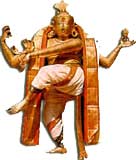
Nataraja i.e. Lord Siva in a dancing pose is worshipped
all over India, by the classical dancers, as the king
of dance. The famous cosmic dance of Siva truly depicts
the nature of India classical dance. A poet says, about
the cosmic dance,"With each step he took he scattered
stars in space. With each movement of his outstretched
arms he enveloped space and time. With his long hair flying
in the wind he dances in ecstasy to the delight of his
devotees."
The
dance of Shiva symbolises the cosmic cycles of
creation and destruction, birth and death. His dance
is therefore the dance of the Universe.
For centuries, Indian culture has accepted that the
dance of Shiva is the dance of life, myths, symbolism,
mystic responses and philosophical explanations all
merely add to the strength of such belief in a power
that transcends the merely mortal, and when the human
dancer enacts this act encompassing concept, he or she
only makes a humble offering of acknowledgement.
The
reason why Indian classical dance speaks of the Temple
Tradition is that, the dance forms were nurtured with
a purpose in the sacred premises of temples. Temple
dancing had a mission : to take art to the people and
conveying a message to the masses. The monotony of the
life of commonness as well as the elite was equally
shared in the premises of a Temple. True religion sanctified
every element with a touch of beauty.
The
Badami and the Aihole Prashasti
in the 6th century A.D. had the illustrations of Nataraja
preaching Natyagama in its pure form during the Chalukyan
period. In the medieval temple tradition, the allegorical
view of dance used for the purpose of entertaining the
gods or the Devas transformed into a divine service.
Temple dancing was institutionalised and the
dancing girls were patronised by the kings and maharajas
and were often respectfully mentioned in many inscriptions
of temples built in the medieval age. The famous temple
of Belur has several epithets glorifying the Hoysala
queen Shantala as Natya Saraswati, Vichitra Suthradhari
etc. The dancing girls of the temples were called Devadasis
and the temple activity was considered as a means of
dedication.
The temples of Khajuraho, Bhubaneswar and Puri echoed
with the lyrics of poet Jayadeva. The Devadasi
system in these temples was a living tradition till
recently. Later, the term Devadasi, which was originally
used in the divine sense was replaced by the term "Bhogastree"
and dance and music were used as a means of attracting
clients.
Top
|
Classical dance forms of India:
India
offers a number of classical dance forms, each of which
can be traced to the different parts of the country.
Each form represents the culture and ethos of a particular
region or a group of people. The
most famous classical forms are Bharatanatyam
of Tamilnadu, Kathakali and Mohiniyattam of Kerala,
Odissi of Orissa, Kathak of Uttarpradesh, Kuchipudi
of Andhrapradesh and Manipuri of Manipur. The common
root of all these dance forms is Bharata's Natyashastra.
Indian
classical dance is divided into 'nritta'- the rhythmic
elements, 'nritya'- the combination of rhythm and expression
and 'natya'- the dramatic element. To appreciate natya
or dance drama, one has to understand and appreciate Indian
legends. Most Indian dances take their themes from India's
rich mythology and folk legends. Hindu Gods and Goddesses
like Vishnu, Shiva, Lakshmi and Sita are all depicted
in these dances. Each dance form also draws inspiration
from stories depicting the life and beliefs of the Indians.
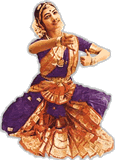
Bharathanatyam is the term coined by E.Krishna
Iyer, one of the freedom fighters to the then Sadir dance.
This dance has now come to stay as the classical dance
that originated in Tamilnadu. But this again has no relevance
today, for it has become deeply rooted in various states
of India.
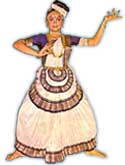
Mohiniyattam
is a female classical dance form of Kerala. It was mainly
performed in the Temples of Kerala. The word Mohini means
a maiden who enacts desire or steals the heart of the
onlookers.
Kathakali
is one of the most dramatic dance forms in India, wherein
the performer dances all through the night
and tells stories of heroes and heroines, Gods and Demons
from the Indian epics, Mahabharata and Ramayana. The
techniques of Kathakali are extremely complicated and
the dancers, mainly men, execute rapid spins, leaps
and freezes with split-second timings.
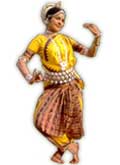
Orissa,
on the Eastern Sea-Coast of India, is the home of the
highly sensuous and lyrical form of dance called Odissi.The
Odissi dancer bends the hips and sways the torso in
curves and flexions known as "Tribhangi" (Triple
Bend) and "Atibhangi" (Semi-circular bend)
from the torso downwards.
Kathak
is a major solo style of Northern India. It is said
to be originated from the Braj region in Uttar Pradesh
by "Kathakars" or story- tellers.
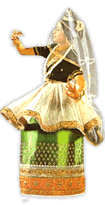
Another
dance form in India, Manipuri originates in beautiful
valley in the North East of India. Lyrical grace,lightness
or delicacy of hand gestures set Manipuri apart from
the geometric structure of Bharatanatyam and the linear
quality of Kathak. The costumes and ornaments in Ras
are colourful and glittering.
|